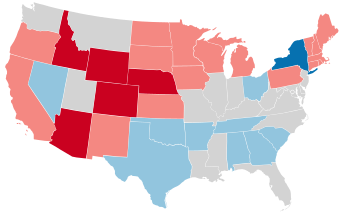
The 1978 United States Senate elections in the middle of Democratic President Jimmy Carter's term. Thirteen seats changed hands between parties, resulting in a net gain of three seats for the Republicans. Democrats nevertheless retained a 58–41 majority.

The 1974 United States Senate elections were held in the wake of the Watergate scandal, Richard M. Nixon's resignation from the presidency, and Gerald Ford's subsequent pardon of Nixon. Economic issues, specifically inflation and stagnation, were also a factor that contributed to Republican losses. As an immediate result of the November 1974 elections, Democrats made a net gain of three seats from the Republicans, as they defeated Republican incumbents in Colorado and Kentucky and picked up open seats in Florida and Vermont, while Republicans won the open seat in Nevada. Following the elections, at the beginning of the 94th U.S. Congress, the Democratic caucus controlled 61 seats, and the Republican caucus controlled 38 seats.

In the 1912–13 United States Senate elections, Democrats gained control of the Senate from the Republicans. Of the 32 seats up for election, 17 were won by Democrats, thereby gaining 4 seats from the Republicans. Two seats were unfilled by state legislators who failed to elect a new senator on time. They were the last Senate elections held before ratification of the 17th Amendment, which established direct elections for all seats in the Senate.
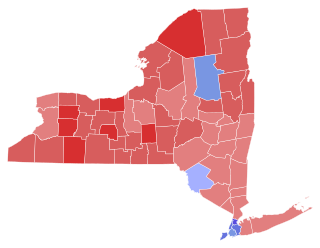
The 1918 New York gubernatorial election took place on November 5, 1918, to elect the Governor and Lieutenant Governor of New York, concurrently with elections to the United States Senate in other states and elections to the United States House of Representatives and various state and local elections.

The 1996 United States Senate election in Arkansas was held on November 5, 1996. Incumbent Democratic U.S. Senator David Pryor decided to retire. Republican Tim Hutchinson won the open seat, becoming the first Republican to win a U.S. Senate seat in Arkansas since Reconstruction. As of 2022, this is the last time Republicans flipped a Senate seat in a presidential year despite losing the state in the presidential election.

The 2018 Arkansas gubernatorial election was held on November 6, 2018, to elect the Governor of Arkansas, concurrently with elections to the United States Senate in other states, elections to the United States House of Representatives, and various state and local elections.

A general election was held in the U.S. state of Alabama on November 6, 2018. All Alabama executive officers were up for election along with all of Alabama's seven seats in the United States House of Representatives. Primary elections took place on June 5, 2018, for both major parties.

United States gubernatorial elections were held on November 8, 2022, in 36 states and three territories. As most governors serve four-year terms, the last regular gubernatorial elections for all but two of the seats took place in 2018 U.S. gubernatorial elections. The gubernatorial elections took place concurrently with several other federal, state, and local elections, as part of the 2022 midterm elections.

The 1978 United States Senate special election in Alabama was held on November 7, 1978. It was a special election to fill the seat which had been held by Senator Jim Allen, who died on June 1. His widow Maryon was appointed on June 8 by governor George Wallace to fill the vacancy until a special election could be held.

The 2020 Vermont gubernatorial election was held on November 3, 2020, to elect the Governor of Vermont. As Vermont does not impose term limits upon its governors, incumbent Republican Governor Phil Scott was eligible to run for reelection to a third two-year term in office. On November 18, 2019, he confirmed that he was running for reelection, but did not yet publicly announce his campaign. On May 28, 2020, he officially announced his candidacy but stated that he would not campaign, maintain a campaign staff, or fundraise because of the state of emergency due to the COVID-19 pandemic in Vermont. The primary was held on August 11. Scott won re-election to a third term in a landslide, defeating Progressive and Democratic nominee, Lieutenant Governor David Zuckerman.

United States gubernatorial elections were held in 1924, in 36 states, concurrent with the House, Senate elections and presidential election, on November 4, 1924.

The 2022 South Carolina gubernatorial election took place on November 8, 2022, to elect the governor of South Carolina. Incumbent Republican Governor Henry McMaster ran for re-election for a second full term in office and secured the Republican nomination in the June 14 primary. Joe Cunningham, former United States Representative from South Carolina's 1st congressional district, was the Democratic nominee. McMaster won the general election with 58% of the vote — a subsequently larger majority than in 2018.

The 2022 Alabama gubernatorial election took place on November 8, 2022, to elect the governor of Alabama. Incumbent Republican Governor Kay Ivey took office on April 10, 2017, upon the resignation of former Governor Robert J. Bentley, and was elected to a full term in 2018. She ran for re-election to a second full term in which she won her re-election bid in a landslide.
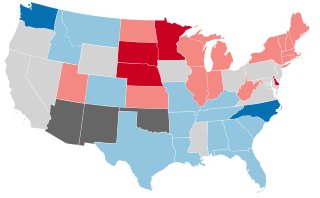
United States gubernatorial elections were held in 1900, in 34 states, concurrent with the House, Senate elections and presidential election, on November 6, 1900.

United States gubernatorial elections were held in 1898, in 28 states, concurrent with the House and Senate elections, on November 8, 1898.

United States gubernatorial elections were held in 1896, in 32 states, concurrent with the House, Senate elections and presidential election, on November 3, 1896.

United States gubernatorial elections were held in 1894, in 28 states, concurrent with the House and Senate elections, on November 6, 1894.
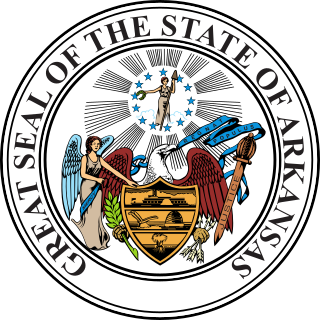
The 1942 Arkansas gubernatorial election was held on November 3, 1942.
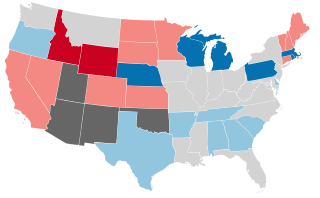
United States gubernatorial elections were held in 1890, in 27 states, concurrent with the House and Senate elections, on November 4, 1890.
United States gubernatorial elections were held on Tuesday November 6, in 26 states, concurrent with the House, Senate elections and presidential election, on November 6, 1888.
